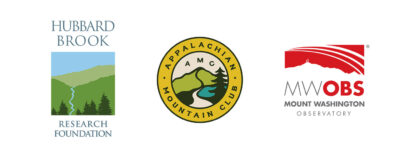New Annual Almanac Chronicles Climate and Ecological Shifts in New Hampshire’s White Mountains
A Collaborative Visual and Scientific Resource Offers an Unprecedented Look at a Changing Landscape
White Mountains, NH — A groundbreaking new publication is set to deepen public understanding of one of New England’s most iconic landscapes. Today marks the official release of the White Mountains Almanac, an annual publication developed through a unique collaboration between the Appalachian Mountain Club (AMC), Mount Washington Observatory (MWOBS), and the Hubbard Brook Research Foundation (HBRF).
With funding support from The Cabot Family Charitable Trust, The Nature Conservancy in New Hampshire, Stephen Walker and Diane DeLuca, and The Hartford Foundation for Public Giving, this richly-illustrated almanac offers a comprehensive, year-in-review exploration of ecological and climatological changes observed in the White Mountains region. Merging scientific rigor with visual storytelling, the publication serves as both a valuable resource for researchers and a compelling guide for nature enthusiasts, educators, policymakers, and the greater public.
“We’re extremely proud to present this gorgeous publication that includes both important science and fun storytelling, illustrated by artist Sarah Kaizar,” Drew Bush, Mount Washington Observatory’s Executive Director, said. “The almanac presents the science in a way that is both accessible and engaging. We believe a publication that tracks the flora, biotic, and weather patterns year after year will prove to be an important tool for the natural resource based economy of the White Mountains. It will no doubt be used for educational programs with our region’s schools and families, in scientific research internationally, and for the millions of visitors that visit this iconic area and each of our institutions.”
Key features of the 2025 edition include month-by-month overviews covering key environmental indicators, detailed seasonal summaries of temperature, precipitation, and extreme weather events, species spotlights and phenological changes, long-term data trends, and stunning accompanying illustrations capturing the beauty and biodiversity of the region by artist Sarah Kaizar.
With contributions from local scientists, naturalists, and community supporters, graduate student Frank Vazzano compiled the data and authored the work during his internship with the three partner nonprofits. The text, he shares, will introduce the reader “to the climatological character of these wonderful mountains, how and where this is changing, and how these changes interact with spheres ranging from ecology to economy, and severe weather to outdoor recreation.”
“Each month is a journey into a seasonal setting, giving you a true sense of place for the White Mountains through a historical, science-driven lens. Not just words, but data we’ve gathered over decades tell the tale of the region, helping us understand, protect, and enjoy these mountains for generations to come. We were fortunate to have Frank as our skilled guide,” says Georgia Murray, AMC Senior Scientist who provided input on AMC’s long-term datasets and analysis.
The almanac is now available in print and digital formats through the participating organizations’ websites (listed below).
HBRF’s staff participation in this project was funded by the National Science Foundation.
About the Partners
Appalachian Mountain Club (AMC):
The Appalachian Mountain Club is the nation’s oldest conservation and recreation organization, committed to fostering the protection, enjoyment, and understanding of the outdoors. Since 1876, AMC has encouraged generations to deepen their passions for the outdoors and helped protect some of the most critical natural environments in the Northeast and Mid-Atlantic regions. Learn more and join at outdoors.org.
Hubbard Brook Research Foundation (HBRF):
The Hubbard Brook Experimental Forest is one of the longest running and most comprehensive ecosystem study sites in the world. Operated and maintained by the U.S. Department of Agriculture, Forest Service since 1955, this 7,800-acre research site is located just north of Plymouth, NH, in the White Mountains. Long-term ecological research at Hubbard Brook is supported by the National Science Foundation along with other agencies and partners. The Hubbard Brook Research Foundation leads outreach and education programs to strengthen connections between science and society. Learn more and donate at hubbardbrook.org.
Mount Washington Observatory (MWOBS):
Mount Washington Observatory is a private, non-profit, member-supported institution dating back to 1932 with a mission to advance understanding of the natural systems that create earth’s weather and climate. It serves this mission by maintaining a weather station on the summit of Mount Washington, performing weather and climate research, conducting innovative science education programs, and interpreting the heritage of the Mount Washington region. Learn more and donate at mountwashington.org.
Media Contacts:
Pamela Brown
Director of Communications, Appalachian Mountain Club
pbrown@outdoors.org
Ellen Estabrook
Communications Manager, Mount Washington Observatory
eestabrook@mountwashington.org
###
Inside the Weather Room: How Mount Washington Observers Monitor the Atmosphere
Inside the Weather Room: How Mount Washington Observers Monitor the Atmosphere By Karl Philippoff As a weather observer on Mount Washington, we take our hourly observations on the observation deck, usually heading out between
From Weather Observer to Intern, to Observer Again
From Weather Observer to Intern, to Observer Again By Madelynn Smith As I rode in the backseat of our Obs van up the Auto Road for the first time as a full-time employee at
From Mountains to More Mountains
From Mountains to More Mountains: This Time with Stronger Winds By Alyssa Bélanger On the observation deck in high winds. Hello there! My name is Alyssa Bélanger and I am a fall





